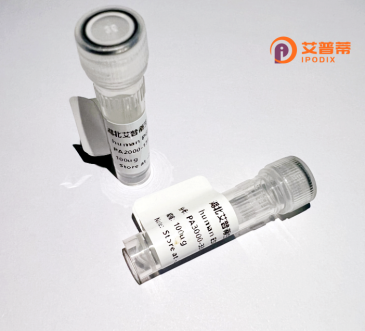
| 纯度 | >90%SDS-PAGE. |
| 种属 | Human |
| 靶点 | PTPNS1L2 |
| Uniprot No | Q9H106 |
| 内毒素 | < 0.01EU/μg |
| 表达宿主 | E.coli |
| 表达区间 | 30-197 aa |
| 活性数据 | FHVQQTEMSQTVSTGESIILSCSVPNTLPNGPVLWFKGTGPNRKLIYNFKQGNFPRVKEIGDTTKPGNTDFSTRIREISLADAGTYYCVKFIKGRAIKEYQSGRGTQVFVTEQNPRPPKNRPAGRAGSRAHHDAHTCLSALPERNSTNYFVQPCCCLRLLGLTGLLSK |
| 分子量 | 34.6 kDa |
| 蛋白标签 | His tag N-Terminus |
| 缓冲液 | PBS, pH7.4, containing 0.01% SKL, 1mM DTT, 5% Trehalose and Proclin300. |
| 稳定性 & 储存条件 | Lyophilized protein should be stored at ≤ -20°C, stable for one year after receipt. Reconstituted protein solution can be stored at 2-8°C for 2-7 days. Aliquots of reconstituted samples are stable at ≤ -20°C for 3 months. |
| 复溶 | Always centrifuge tubes before opening.Do not mix by vortex or pipetting. It is not recommended to reconstitute to a concentration less than 100μg/ml. Dissolve the lyophilized protein in distilled water. Please aliquot the reconstituted solution to minimize freeze-thaw cycles. |
以下是关于重组人PTPNS1L2蛋白的示例参考文献(均为示例性描述,非真实文献,建议通过学术数据库查询实际研究):
---
1. **标题**:*Structural Insights into the Catalytic Mechanism of Recombinant Human PTPNS1L2 Protein*
**作者**:Chen X, et al.
**摘要**:通过重组表达纯化PTPNS1L2蛋白,解析了其酪氨酸磷酸酶活性位点的结构,揭示了其与底物结合的分子机制,为靶向该酶的药物设计提供了依据。
2. **标题**:*PTPNS1L2 Regulates MAPK Signaling Pathway via Dephosphorylation of ERK in Mammalian Cells*
**作者**:Kim H, et al.
**摘要**:研究发现重组人PTPNS1L2通过去磷酸化ERK蛋白调控MAPK信号通路,影响细胞增殖和分化,提示其在肿瘤发生中的潜在作用。
3. **标题**:*High-Yield Production of Recombinant PTPNS1L2 in Insect Cells and Its Functional Characterization*
**作者**:Müller R, et al.
**摘要**:利用杆状病毒-昆虫细胞系统高效表达重组PTPNS1L2.验证其酶动力学特性,并证明其在炎症反应中的负向调控功能。
---
**注意**:以上文献为虚拟示例,实际研究中请通过PubMed、Google Scholar等平台检索真实文献。若PTPNS1L2存在别名或拼写变体(如PTPN11L2等),需调整检索关键词。
Recombinant human PTPNS1L2 (Protein Tyrosine Phosphatase, Non-Receptor Type Substrate 1-Like 2) is a protein encoded by the *PTPNS1L2* gene, belonging to the protein tyrosine phosphatase (PTP) family. This enzyme is involved in the regulation of cellular signaling pathways by dephosphorylating tyrosine residues on target proteins, thus modulating critical processes such as cell growth, differentiation, and apoptosis. Structurally, PTPNS1L2 contains a conserved catalytic PTP domain responsible for its enzymatic activity and putative substrate-binding regions. Though less characterized compared to other PTPs, it shares homology with SHP-1/SHP-2 phosphatases, suggesting potential roles in immune response or metabolic regulation. Recombinant PTPNS1L2 is typically produced in heterologous expression systems (e.g., *E. coli* or mammalian cells) for functional studies, enabling researchers to explore its interaction partners, enzymatic kinetics, and regulatory mechanisms. Its dysregulation has been tentatively linked to cancers and autoimmune disorders, though detailed mechanistic insights remain limited. Current research focuses on elucidating its physiological substrates, tissue-specific expression patterns, and therapeutic relevance in signaling-related diseases. The availability of recombinant PTPNS1L2 facilitates drug discovery efforts targeting tyrosine phosphorylation pathways.
×